Intermittent fasting has become one of the most popular strategies for weight loss and better health — and the 16:8 intermittent fasting plan is one of the easiest ways to get started.
Instead of counting calories or cutting out entire food groups, this method focuses on when you eat, giving your body time to burn fat, improve digestion, and regulate hormones naturally.
For many people, it’s a flexible approach that not only supports weight loss but also boosts energy, mental clarity, and overall wellness.
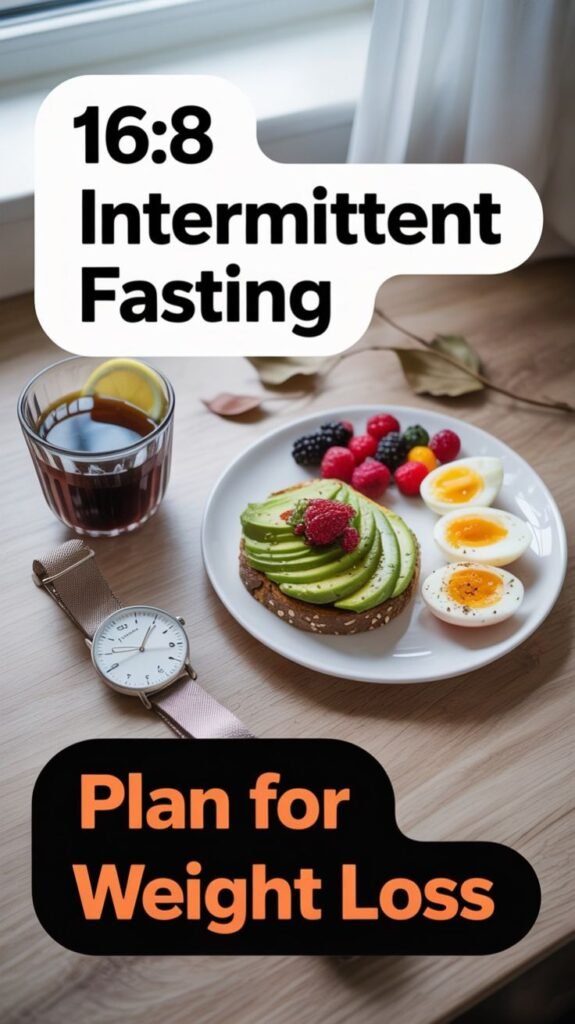
In this guide, we’ll break down exactly how the 16:8 intermittent fasting schedule works, the science behind why it’s so effective, and practical tips to make it a sustainable part of your lifestyle.
You’ll learn the best foods to eat during your eating window, how to curb hunger while fasting, and ways to combine intermittent fasting with exercise for even faster results.
Whether your goal is to lose weight, reduce belly fat, or build a healthier daily routine, this plan can help you take control of your health without feeling deprived.
Just so you know: This post may include affiliate links, meaning we may earn a small commission if you choose to purchase — at no extra cost to you. We only recommend trusted wellness tools, books, and products that support healthy habits like intermittent fasting and long-term weight loss.
What Is Intermittent Fasting (IF)?

Intermittent fasting (IF) is an eating pattern that alternates between periods of eating and fasting. Unlike traditional diets that focus on what to eat, intermittent fasting focuses on when you eat.
The idea is to give your body regular periods without food, allowing it to burn fat more efficiently, improve metabolic health, and promote overall wellness.
1. How Intermittent Fasting Works
When you fast, your body undergoes several metabolic changes:
- Insulin levels drop: Lower insulin allows stored fat to be released and used as energy.
- Growth hormone increases: This supports fat burning and preserves lean muscle.
- Cellular repair is enhanced: Processes like autophagy help remove damaged cells and promote longevity.
The key principle is that you’re not eating for extended periods, which gives your body time to switch from burning glucose (from food) to burning stored fat for energy.
2. Common Intermittent Fasting Methods
There are several popular intermittent fasting schedules:
- 16:8 Method: Fast for 16 hours and eat within an 8-hour window. Most common and beginner-friendly.
- 5:2 Method: Eat normally five days a week, then reduce calorie intake to 500–600 calories for two non-consecutive days.
- Alternate-Day Fasting: Alternate between normal eating days and fasting days (or very low calorie days).
- Eat-Stop-Eat: One or two 24-hour fasts per week.
3. Benefits of Intermittent Fasting
Intermittent fasting is associated with multiple health benefits, including:
- Weight and fat loss: By reducing calorie intake and improving insulin sensitivity, IF helps burn stored fat.
- Improved metabolic health: Fasting periods improve insulin response and reduce blood sugar fluctuations.
- Better heart health: Some studies show reduced cholesterol, triglycerides, and inflammation markers.
- Enhanced brain function: IF may improve focus, mental clarity, and reduce the risk of neurodegenerative diseases.
- Cellular repair and longevity: Fasting promotes autophagy, the body’s natural process of cleaning out damaged cells.
4. Who Can Practice Intermittent Fasting
- Healthy adults looking to lose weight or improve metabolic health.
- Beginners can start with shorter fasting periods (12–14 hours) and gradually increase.
- Active individuals can combine IF with exercise for improved fat burning and muscle preservation.
Note: Pregnant or breastfeeding women, people with certain medical conditions, or those with a history of eating disorders should consult a healthcare professional before starting intermittent fasting.
5. Tips for Success
- Stay hydrated during fasting hours with water, herbal tea, or black coffee.
- Focus on nutrient-dense meals during eating windows to stay satisfied.
- Be consistent: Regular fasting windows yield better results than occasional fasting.
- Listen to your body: Adjust the fasting duration or method if you feel overly fatigued or dizzy.
Bottom line: Intermittent fasting is a flexible, evidence-based eating pattern that prioritizes when you eat rather than what you eat.
By creating periods of fasting, your body can burn fat more efficiently, improve metabolic health, and support long-term wellness.

HydroMATE Electrolytes Powder Drink Mix Packets Hydration Accelerator Low Sugar Rapid Party Recovery Plus Vitamin C Variety Pack 30 Count
What Is the 16:8 Intermittent Fasting Method?
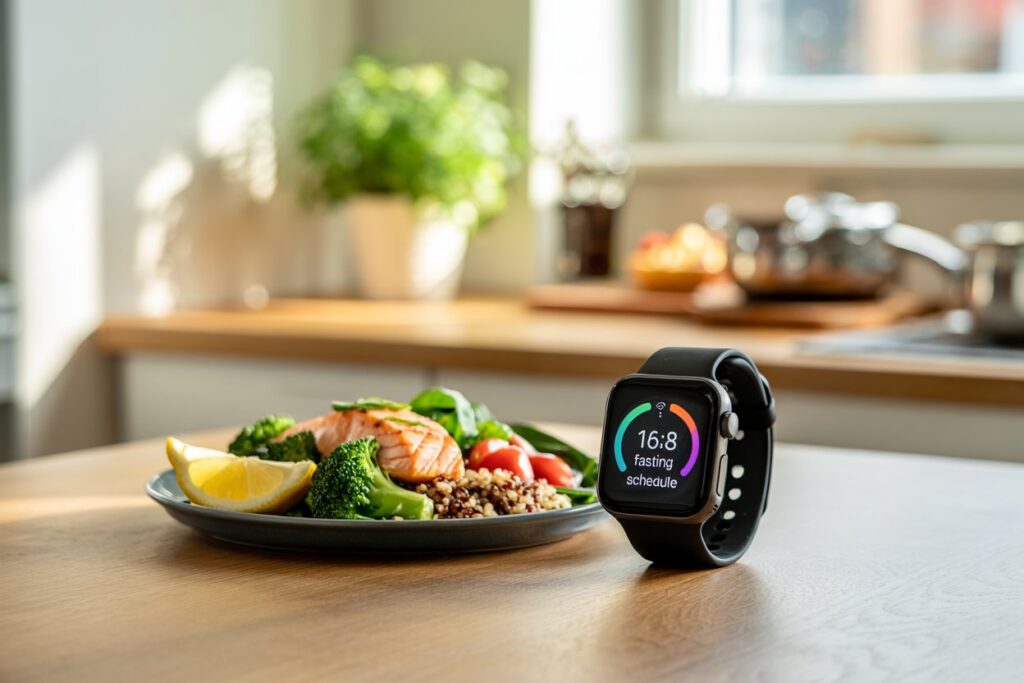
The 16:8 fasting schedule involves fasting for 16 hours and eating during an 8-hour window each day. A typical schedule might be:
- 10 a.m. to 6 p.m.
- 12 p.m. to 8 p.m.
- 9 a.m. to 5 p.m.
During the 16-hour fast, you abstain from all calories and stick to water, black coffee, or herbal teas.
The 16:8 intermittent fasting method is one of the most popular and sustainable forms of intermittent fasting.
It involves dividing your day into two windows: a fasting period of 16 hours and an eating period of 8 hours. During the fasting window, you abstain from all calories, while during the eating window, you consume all your meals and snacks.
1. How It Works
The 16:8 method works by giving your body extended periods without food, which helps:
- Lower insulin levels, making it easier for your body to burn stored fat.
- Promote fat loss while preserving muscle mass.
- Support cellular repair and longevity through processes like autophagy.
For example, a typical schedule might be:
- Fasting window: 8 PM – 12 PM (next day)
- Eating window: 12 PM – 8 PM
During the fasting hours, you can drink water, black coffee, or unsweetened tea, but no calories are consumed. Once the eating window starts, you consume balanced, nutrient-dense meals.
2. Benefits of the 16:8 Method
- Simplicity: No complicated calorie counting; you just eat within a set timeframe.
- Flexibility: You can adjust the eating window to match your lifestyle (e.g., 11 AM – 7 PM or 1 PM – 9 PM).
- Supports fat loss: By extending fasting periods, your body shifts to burning fat for energy.
- Improved insulin sensitivity: Helps regulate blood sugar and reduces fat storage.
- Sustainable: Many find it easier to maintain than more extreme fasting schedules.
3. Who Can Use the 16:8 Method
- Beginners: The 16:8 method is beginner-friendly because it is not overly restrictive.
- Busy individuals: Reduces the number of meals you need to plan and prepare.
- Those seeking fat loss: Particularly effective when combined with a balanced diet and exercise.
Note: People with certain medical conditions, pregnant or breastfeeding women, or individuals with a history of disordered eating should consult a healthcare provider before starting intermittent fasting.
4. Tips for Success
- Start gradually: If 16 hours feels long at first, try 12:12 or 14:10 fasting windows and work up to 16:8.
- Stay hydrated: Drink water, herbal tea, or black coffee during fasting hours to curb hunger.
- Focus on nutrient-dense meals: Include protein, fiber, healthy fats, and complex carbs to feel full and satisfied during the eating window.
- Be consistent: Regular adherence is key to seeing fat loss and metabolic benefits.
Bottom line: The 16:8 intermittent fasting method is a simple, effective, and sustainable approach to support fat loss, improve metabolic health, and simplify your daily eating routine.
By fasting for 16 hours and eating during an 8-hour window, you give your body time to burn fat, regulate insulin, and improve overall health.
Best Intermittent Fasting Window to Lose Belly Fat

The best window to lose belly fat is often 12 p.m. to 8 p.m. This allows your body to align with its natural circadian rhythm while maximizing fat burn in the fasting period.
Stay Hydrated. Feel Energized. Perform Your Best.
Boost your workouts, speed recovery, and keep your energy high with HydroMATE Electrolytes. Perfect for fitness, busy days, or anytime you need fast hydration support.
Get Yours Here
If your main goal is reducing belly fat, the timing of your eating and fasting windows can make a difference. While intermittent fasting in general helps regulate insulin, improve metabolism, and promote fat burning, certain windows may be more effective for targeting abdominal fat.
1. Why Belly Fat Responds to Fasting
Belly fat, also known as visceral fat, is more metabolically active than subcutaneous fat. This means it responds well to interventions that improve insulin sensitivity and encourage fat mobilization. Intermittent fasting helps:
- Lower insulin levels, allowing fat cells to release stored fat more easily.
- Increase growth hormone levels, which promote fat breakdown and muscle preservation.
- Improve overall calorie control without constant food restriction.
2. The Most Popular Window: 16:8
- Fasting period: 16 hours (e.g., 8 PM – 12 PM next day)
- Eating period: 8 hours (e.g., 12 PM – 8 PM)
Why it works for belly fat:
- Provides a long enough fasting window for insulin levels to drop and fat oxidation to increase.
- Encourages consistent eating patterns, reducing late-night snacking, which often contributes to belly fat.
- Flexible enough to fit around work and lifestyle schedules.
3. Other Effective Windows
While 16:8 is most common, other windows can also be effective:
- 14:10 fasting window: Easier for beginners. You fast for 14 hours and eat during a 10-hour window. Still allows for insulin reduction and fat burning while being less restrictive.
- 18:6 fasting window: More advanced, slightly longer fast. Can accelerate fat loss, but may be harder to maintain long-term.
- Alternate day fasting or 5:2 method: Effective for some, but more extreme approaches may not be sustainable and can increase hunger or cravings.
4. Meal Timing Tips to Maximize Belly Fat Loss
- Front-load calories: Consider eating your largest meal earlier in the eating window to fuel activity and reduce late-night eating.
- High-protein, fiber-rich meals: Protein preserves muscle and fiber keeps you full, reducing overall calorie intake.
- Healthy fats and complex carbs: Include avocados, nuts, whole grains, and vegetables to sustain energy and prevent blood sugar spikes.
- Avoid late-night snacking: Eating close to bedtime can disrupt fat burning and digestion, hindering belly fat loss.
5. Combining Fasting With Exercise
- Morning fasted workouts: Some people find that light cardio or strength training in a fasted state helps accelerate fat burning.
- Strength training during eating window: Muscle-building helps increase metabolism and promotes long-term fat loss, especially around the belly.
6. Consistency is Key
The best fasting window is the one you can stick to consistently. Studies show that intermittent fasting combined with a balanced diet and regular exercise leads to significant reductions in abdominal fat over time.
Bottom line: For most people targeting belly fat, a 16:8 intermittent fasting schedule is ideal. It provides a balance between effective fasting for fat loss and flexibility for sustainable eating. Pairing this fasting window with nutrient-dense meals, regular exercise, and consistent routines can help you see measurable reductions in belly fat over weeks and months.
16:8 Fasting Weight Loss Results (1 Week to 8 Weeks)

- 1 Week: Slight drop in bloating and water weight
- 4 Weeks: Noticeable fat loss and improved digestion
- 8 Weeks: Enhanced body composition and visible waistline changes
Many women following the 16:8 method report a flatter stomach and reduced cravings within the first few weeks.
How Long Does It Take for 16:8 Intermittent Fasting to Work?
Results vary by person, but many see initial results in 7–14 days. Consistency with both the fasting schedule and healthy eating speeds up fat loss, especially around the belly.
Intermittent fasting, particularly the 16:8 method, has become popular for weight loss because it’s simple, sustainable, and doesn’t require strict calorie counting.
However, results vary based on factors like age, sex, starting weight, activity level, and food choices during the eating window. Here’s what you can realistically expect from 1 week to 8 weeks.
Week 1: Adjusting to Fasting
- What happens: Your body is adapting to a new eating schedule. You may feel hunger at the usual meal times, but most people report that hunger becomes manageable after a few days.
- Weight loss potential: 1–3 pounds (0.5–1.5 kg), mostly from water weight and reduced bloating.
- Tips for success:
- Stay hydrated with water, black coffee, or herbal tea.
- Focus on nutrient-dense foods during the eating window.
- Avoid breaking your fast with sugary or processed foods.
Weeks 2–3: Fat Loss Begins
- What happens: Your body begins using stored fat for energy more efficiently as insulin levels stabilize during fasting periods. You may notice clothes fitting looser and slight reductions in body measurements.
- Weight loss potential: 2–5 pounds (1–2.5 kg) depending on diet quality and activity level.
- Tips for success:
- Incorporate strength training or regular exercise to maintain muscle mass.
- Track portion sizes to avoid overeating during your eating window.
- Include high-protein meals to support satiety and metabolism.
Weeks 4–6: Visible Changes
- What happens: Many people report visible improvements in body composition, such as reduced belly fat and overall slimming. Energy levels often increase, and digestion may improve.
- Weight loss potential: 4–8 pounds (2–4 kg), with fat loss more noticeable than initial water weight changes.
- Tips for success:
- Mix in cardio, resistance training, or HIIT workouts to accelerate fat loss.
- Continue emphasizing whole, nutrient-dense foods with fiber and protein.
- Avoid frequent alcohol, sugary drinks, or processed snacks during eating windows.
Weeks 7–8: Consistency Pays Off
- What happens: With sustained adherence, 16:8 intermittent fasting can lead to significant fat loss, improved insulin sensitivity, and better energy regulation. Many people also notice reductions in bloating and cravings.
- Weight loss potential: 6–12 pounds (3–6 kg), depending on initial body weight and adherence.
- Tips for success:
- Monitor your body’s response and adjust calorie intake if necessary.
- Focus on long-term habits rather than rapid results.
- Consider intermittent fasting as part of an overall healthy lifestyle for sustainable weight management.
Important Considerations
- Individual differences matter: Men may lose weight faster than women initially due to higher muscle mass and metabolism.
- Diet quality is crucial: Fasting alone is not a magic solution; the type of foods you eat during the eating window has a major impact on results.
- Non-scale victories: Even if the scale changes slowly, improvements in energy, focus, digestion, and body composition are meaningful indicators of success.
Bottom line: Most people see initial results within the first week, with noticeable fat loss and body composition changes by weeks 4–8.
Consistency, balanced meals, and healthy lifestyle habits are the key to maximizing results with 16:8 intermittent fasting.
What to Eat During the 8-Hour Eating Window
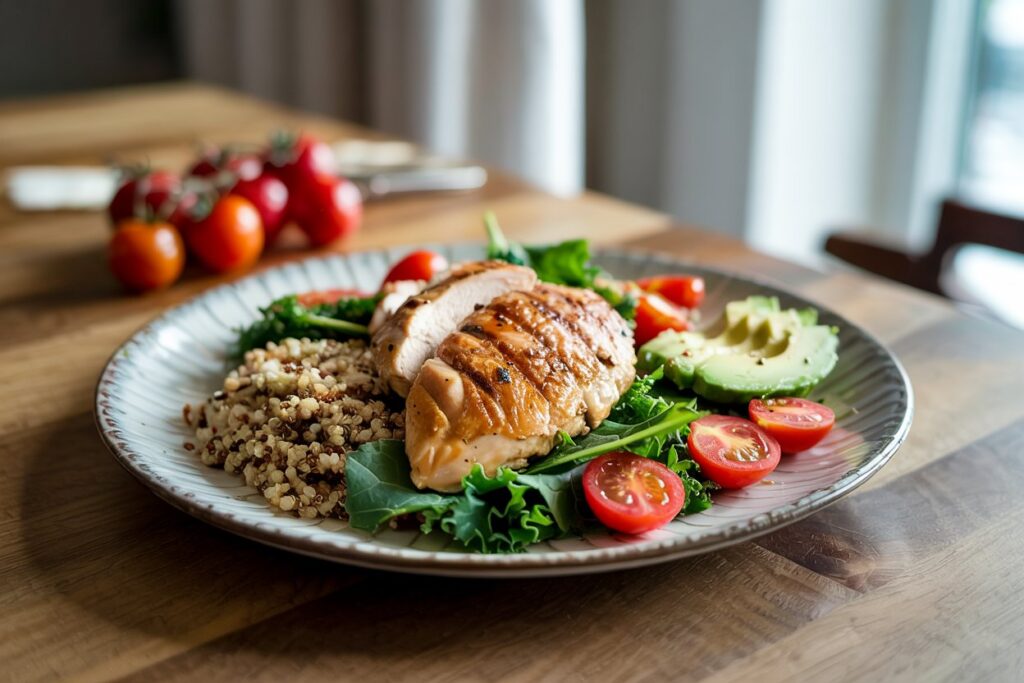
Focus on nutrient-dense foods like:
click each of the listed products and buy on amazon.
- Leafy greens and colorful vegetables
- Whole grains (quinoa, oats, brown rice)
- Lean proteins (chicken, turkey, tofu, legumes)
- Healthy fats (avocados, nuts, olive oil)
Foods to avoid:
- Sugary drinks and snacks
- Refined carbs (white bread, pasta)
- Fried and processed foods
The 8-hour eating window in 16:8 intermittent fasting is your opportunity to provide your body with nutrient-dense foods that fuel energy, support metabolism, and keep you satisfied until your next fast. Eating the right foods is just as important as the timing of your meals.
1. Prioritize Protein
Protein helps preserve muscle mass, keeps you full longer, and supports fat loss. Include a source of protein in each meal.
Examples:
- Lean meats: chicken, turkey, lean beef
- Fish: salmon, cod, tuna
- Eggs: whole or egg whites
- Plant-based: tofu, tempeh, lentils, chickpeas
- Dairy: Greek yogurt, cottage cheese
Tip: Aim for 20–30 grams of protein per meal to maximize satiety and maintain lean muscle during fasting.
2. Include Healthy Fats
Healthy fats help regulate hormones, improve satiety, and support brain health. Pair fats with protein or complex carbs for balanced meals.
Examples:
- Avocado
- Nuts and seeds (almonds, walnuts, chia, flaxseeds)
- Olive oil, coconut oil, or avocado oil
- Fatty fish (salmon, mackerel)
Tip: Use fats as a complement, not the main ingredient, to avoid excess calorie intake.
3. Choose Complex Carbohydrates
Complex carbs provide sustained energy, fiber for digestion, and essential vitamins and minerals. They help prevent blood sugar spikes and crashes.
Examples:
- Quinoa, brown rice, oats
- Sweet potatoes
- Whole-grain bread or pasta
- Lentils, beans, chickpeas
- Vegetables: broccoli, carrots, zucchini, spinach
Tip: Fill half your plate with vegetables for fiber, volume, and nutrients without excess calories.
4. Enjoy Fruits in Moderation
Fruits provide natural sweetness, vitamins, minerals, and antioxidants.
Best choices during your eating window:
- Berries (strawberries, blueberries, raspberries)
- Apples, pears, kiwi
- Oranges, peaches, grapes (moderation advised)
Tip: Pair fruits with protein or healthy fats to slow sugar absorption and maintain fullness.
5. Stay Hydrated With Smart Drinks
While water is the primary beverage during fasting hours, during your eating window you can include:
- Water (still or sparkling)
- Herbal teas
- Black coffee (without excess sugar or cream)
- Unsweetened almond or oat milk in smoothies
Tip: Avoid sugary drinks and alcohol during the eating window if your goal is fat loss.
6. Sample Meal Combinations
- Lunch: Grilled salmon with quinoa, steamed broccoli, and avocado slices
- Snack: Greek yogurt with blueberries and chia seeds
- Dinner: Grilled chicken with roasted sweet potatoes and a mixed green salad with olive oil
7. Tips for Success
- Plan your meals: Prepping meals in advance prevents poor choices during your eating window.
- Balance macronutrients: Each meal should ideally include protein, complex carbs, healthy fats, and fiber-rich vegetables.
- Avoid overcompensation: Eating excessively or choosing high-calorie processed foods can undo fasting benefits.
- Listen to hunger cues: Eat until satisfied, not stuffed. Intermittent fasting is about structure, not starvation.
Bottom line: The 8-hour eating window is not a free-for-all—it’s a chance to fuel your body with nutrient-dense, satisfying foods.
Prioritize protein, complex carbs, healthy fats, and fiber-rich fruits and vegetables to maximize energy, fat loss, and overall health while practicing 16:8 intermittent fasting.
Can I Eat Fruits During the Eating Window?

Yes. Fruits like berries, apples, and oranges are high in fiber and water—ideal for satiety and nutrient intake.
Yes, fruits can absolutely be part of your eating window when practicing intermittent fasting. They are nutrient-dense, naturally sweet, and provide fiber, vitamins, and antioxidants that support overall health. However, there are some considerations to keep in mind to get the most benefit from your fasting routine.
1. Timing Matters
Fruits should be consumed during the eating window, not during fasting hours, because they contain natural sugars (fructose) that will break your fast. Eating fruits within your 8-hour window helps you take advantage of their nutrients without interfering with fat-burning or insulin regulation.
2. Best Fruit Choices
Not all fruits are equal in terms of sugar content and glycemic impact.
- Lower-sugar options: Berries (strawberries, blueberries, raspberries), apples, pears, and kiwi. These are high in fiber and antioxidants while being moderate in natural sugar.
- Moderate-sugar options: Oranges, grapes, peaches, and pineapple. These can be enjoyed in moderation, especially post-workout when your body can use the natural sugar for energy.
- High-sugar options: Bananas, mangoes, and dried fruits. These are nutrient-rich but higher in sugar, so portion control is key.
3. Pair Fruits With Protein or Healthy Fats
Combining fruits with protein or healthy fats can help slow digestion, stabilize blood sugar, and keep you feeling full longer. Examples include:
- Apple slices with almond butter
- Berries mixed into Greek yogurt or cottage cheese
- Banana slices with a handful of walnuts
4. Portion Control
Even though fruits are healthy, consuming large quantities can add excess calories and sugar, which may reduce fat loss benefits. Stick to 1–2 servings per meal during your eating window.
5. Benefits of Including Fruits
- Provides essential vitamins and minerals for overall health.
- Supports digestive health due to high fiber content.
- Offers natural sweetness that can help curb cravings for processed sugar.
- Adds antioxidants that reduce inflammation and support cellular repair.
Bottom line: Fruits are not only safe but recommended during your eating window.
The key is to eat them in moderation, choose lower-sugar options when possible, and pair them with protein or healthy fats to maintain stable energy and satiety.

16/8 Intermittent Fasting 7-Day Meal Plan (Sample)
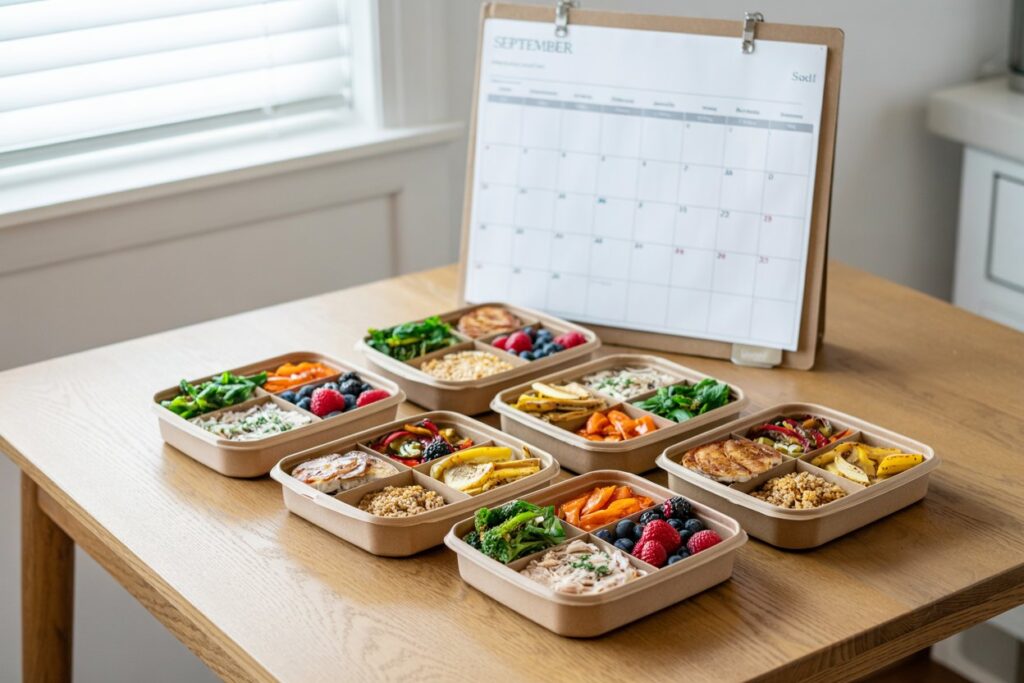
Day 1 Example:
- 12:00 PM: Greek yogurt + almonds + berries
- 3:00 PM: Grilled chicken salad with olive oil vinaigrette
- 6:00 PM: Quinoa with steamed veggies + salmon
Repeat similar structure for 7 days, rotating lean proteins, whole grains, and healthy fats.
Fasting Window: 8 PM – 12 PM (next day)
Eating Window: 12 PM – 8 PM
This meal plan focuses on nutrient-dense, whole foods to support weight loss, muscle maintenance, and energy levels while practicing 16:8 intermittent fasting.
Each day targets approximately 1,800–2,000 calories for women and 2,200–2,400 for men, adjustable based on individual needs.
Day 1
Meal 1 (12 PM): Grilled Chicken Salad – 550 calories
- 4 oz grilled chicken breast
- 2 cups mixed greens (spinach, arugula)
- ½ avocado
- 1 tbsp olive oil + lemon dressing
- ½ cup cherry tomatoes
- ¼ cup shredded carrots
Meal 2 (3 PM): Greek Yogurt Parfait – 350 calories
- ¾ cup Greek yogurt (low-fat)
- ½ cup mixed berries
- 1 tbsp chia seeds
- 1 tsp honey
Meal 3 (7 PM): Baked Salmon with Quinoa and Broccoli – 700 calories
- 4 oz baked salmon
- ½ cup cooked quinoa
- 1 cup steamed broccoli
- 1 tsp olive oil drizzle
- Season with herbs and lemon
Day 2
Meal 1 (12 PM): Egg & Veggie Wrap – 500 calories
- 2 whole eggs + 2 egg whites scrambled
- 1 whole-grain tortilla
- ½ cup sautéed spinach and mushrooms
- 1 tsp olive oil
Meal 2 (3 PM): Almond Snack – 300 calories
- ¼ cup raw almonds
- 1 small apple
Meal 3 (7 PM): Turkey & Sweet Potato Bowl – 700 calories
- 4 oz ground turkey
- ½ cup roasted sweet potatoes
- 1 cup roasted Brussels sprouts
- 1 tsp olive oil
Day 3
Meal 1 (12 PM): Tuna Salad Lettuce Wraps – 550 calories
- 1 can tuna in water
- 2 tbsp Greek yogurt
- 1 tsp Dijon mustard
- 2–3 large romaine leaves
- ½ cup chopped celery and red onion
Meal 2 (3 PM): Protein Smoothie – 350 calories
- 1 scoop protein powder
- 1 cup unsweetened almond milk
- ½ banana
- ½ cup frozen berries
- 1 tsp chia seeds
Meal 3 (7 PM): Grilled Chicken with Brown Rice & Veggies – 700 calories
- 4 oz grilled chicken
- ½ cup cooked brown rice
- 1 cup roasted zucchini and bell peppers
- 1 tsp olive oil
Day 4
Meal 1 (12 PM): Quinoa & Chickpea Salad – 500 calories
- ½ cup cooked quinoa
- ½ cup chickpeas
- 1 cup mixed greens
- 1 tbsp olive oil + lemon juice
Meal 2 (3 PM): Greek Yogurt with Almonds – 350 calories
- ¾ cup Greek yogurt
- 2 tbsp sliced almonds
- ¼ cup blueberries
Meal 3 (7 PM): Baked Cod with Sweet Potato & Broccoli – 700 calories
- 4 oz baked cod
- ½ cup roasted sweet potatoes
- 1 cup steamed broccoli
- 1 tsp olive oil
Day 5
Meal 1 (12 PM): Spinach & Feta Omelette – 500 calories
- 2 whole eggs + 2 egg whites
- ½ cup spinach
- 2 tbsp feta cheese
- 1 tsp olive oil
Meal 2 (3 PM): Mixed Nuts & Fruit – 350 calories
- ¼ cup walnuts
- 1 small pear
Meal 3 (7 PM): Grilled Chicken with Quinoa & Roasted Veggies – 700 calories
- 4 oz grilled chicken
- ½ cup quinoa
- 1 cup roasted zucchini and bell peppers
- 1 tsp olive oil
Day 6
Meal 1 (12 PM): Lentil & Veggie Bowl – 500 calories
- ½ cup cooked lentils
- 1 cup roasted vegetables (carrots, broccoli, bell peppers)
- 1 tsp olive oil
Meal 2 (3 PM): Protein Smoothie – 350 calories
- 1 scoop protein powder
- 1 cup unsweetened almond milk
- ½ cup frozen berries
- ½ banana
Meal 3 (7 PM): Baked Salmon with Brown Rice & Asparagus – 700 calories
- 4 oz baked salmon
- ½ cup cooked brown rice
- 1 cup steamed asparagus
- 1 tsp olive oil
Day 7
Meal 1 (12 PM): Avocado Toast with Eggs – 500 calories
- 2 slices whole-grain bread
- ½ avocado
- 2 eggs, poached or scrambled
- Sprinkle of black pepper
Meal 2 (3 PM): Greek Yogurt with Berries & Chia – 350 calories
- ¾ cup Greek yogurt
- ½ cup mixed berries
- 1 tsp chia seeds
Meal 3 (7 PM): Turkey & Sweet Potato Bowl – 700 calories
- 4 oz ground turkey
- ½ cup roasted sweet potatoes
- 1 cup roasted green beans
- 1 tsp olive oil
Tips for Success:
- Stay hydrated: Drink plenty of water during fasting hours.
- Adjust portions: Increase or decrease portion sizes based on your personal calorie needs and activity level.
- Include protein in every meal: Helps keep you full and supports muscle maintenance.
- Plan ahead: Prepping meals in advance makes fasting easier and reduces the temptation to overeat.
This 7-day meal plan is balanced, easy to follow, and optimized for sustainable weight loss and energy while practicing 16:8 intermittent fasting.
How Many Calories to Eat During 16:8 Intermittent Fasting
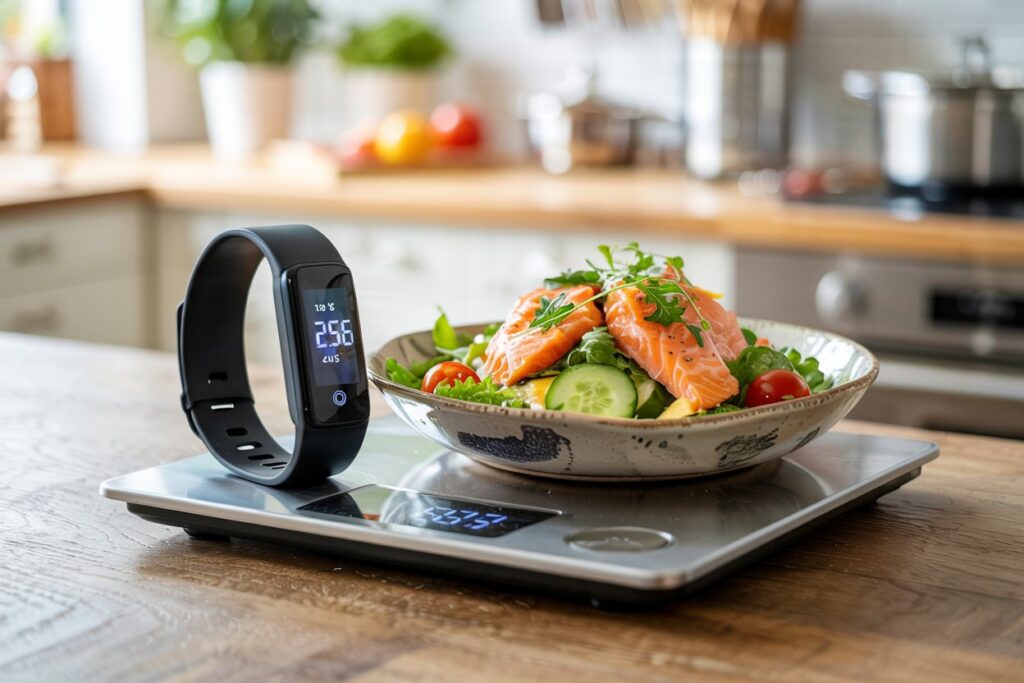
While 16:8 doesn’t restrict calories by default, a general range is:
- Women: 1,200–1,600 calories/day
- Men: 1,600–2,000 calories/day
To lose weight efficiently, stay in a slight calorie deficit while focusing on high-protein, high-fiber meals.
Intermittent fasting is not a license to eat unlimited calories during your eating window. To see results—whether weight loss, improved energy, or better metabolic health—it’s important to understand how many calories to consume while practicing the 16:8 method.
1. Understanding Calorie Needs
Your daily calorie needs depend on several factors:
- Age and sex: Younger people and men often require more calories than older adults and women.
- Activity level: Sedentary individuals need fewer calories, while active people or those who exercise regularly require more.
- Weight goals: To lose weight, you need a calorie deficit. To maintain weight, calories should roughly match your energy expenditure.
A rough guideline for adults:
- Women: 1,500–2,000 calories per day for weight loss, 2,000–2,500 to maintain weight
- Men: 2,000–2,500 calories per day for weight loss, 2,500–3,000 to maintain weight
These numbers are flexible and should be adjusted based on how your body responds.
2. Calorie Distribution During the Eating Window
In the 16:8 method, your meals typically fall within an 8-hour window. This could mean 2–3 meals depending on your schedule.
- 2 meals: Eat two larger, balanced meals, each providing roughly 45–50% of your daily calories, with a small snack if needed.
- 3 meals: Eat three smaller meals, distributing calories evenly to prevent overeating and maintain energy levels.
Example for a woman aiming for 1,800 calories:
- Meal 1: 700 calories
- Meal 2: 700 calories
- Snack: 400 calories
The goal is to get enough nutrients without exceeding total calorie needs.
3. Focus on Nutrient Density
Even within calorie limits, what you eat matters:
- Protein: Chicken, eggs, fish, tofu, Greek yogurt – keeps you full and preserves muscle mass.
- Fiber: Vegetables, fruits, oats, lentils – slows digestion and reduces hunger.
- Healthy fats: Avocados, nuts, olive oil – support satiety and hormone health.
- Complex carbs: Quinoa, brown rice, sweet potatoes – provide steady energy without blood sugar spikes.
4. Avoid Overcompensation
A common mistake is overeating highly processed or calorie-dense foods during eating windows. This can negate fasting benefits and lead to weight gain. Stick to whole foods and balanced meals, even if you feel very hungry after fasting.
5. Adjusting Calories Based on Goals
- Fat loss: Aim for a moderate calorie deficit, typically 300–500 fewer calories than your maintenance level.
- Muscle maintenance or gain: Ensure adequate protein and slightly higher calories, focusing on nutrient-dense sources.
- Sustainable fasting: Avoid aggressive calorie restriction, which can cause fatigue, irritability, and nutrient deficiencies.
6. Listening to Your Body
While calorie tracking can help, pay attention to hunger cues and energy levels. Intermittent fasting is meant to be flexible; rigidly sticking to numbers isn’t necessary if you feel energized and are meeting your goals.
Bottom line: There’s no one-size-fits-all calorie count for 16:8 intermittent fasting. The key is to eat enough to fuel your body during eating windows, prioritize nutrient-dense foods, and maintain a moderate calorie deficit if weight loss is your goal.
By doing so, intermittent fasting becomes a sustainable, effective approach for long-term health and fat loss.
Foods to Avoid While Intermittent Fasting

Intermittent fasting is not just about skipping meals—it’s a strategy that allows your body to lower insulin levels, burn stored fat, and support cellular repair processes.
While fasting, certain foods and beverages can break your fast, spike blood sugar, or hinder fat-burning, so it’s important to know what to avoid. Below is a comprehensive guide.
1. Sugary Foods and Drinks
This includes candy, chocolate bars, pastries, sodas, fruit juices, and other desserts.
- Why it’s a problem: Sugar triggers a rapid spike in blood sugar and insulin, effectively ending your fast. This not only interrupts fat-burning but can also lead to energy crashes, mood swings, and increased cravings.
- Additional impact: Regular consumption of sugary foods may promote belly fat, inflammation, and insulin resistance, which counteracts many of the benefits of intermittent fasting.
- Better alternatives: Stick to water, sparkling water, black coffee, or unsweetened herbal teas during fasting periods. If you need something sweet, consider a small portion of berries during your eating window.
2. Highly Processed Snacks
Examples include chips, crackers, instant noodles, packaged baked goods, and pre-made snack bars.
- Why it’s a problem: Processed snacks are often loaded with refined carbohydrates, unhealthy oils, sodium, and additives that trigger cravings, bloating, and rapid fluctuations in blood sugar. Eating these during fasting periods or even during eating windows can sabotage weight loss goals.
- Better alternatives: Choose whole foods like boiled eggs, raw nuts, Greek yogurt, or fresh fruits and vegetables. These options provide nutrients, fiber, and protein without causing spikes in blood sugar.
3. Refined Carbohydrates
This category includes white bread, white rice, pasta, pastries, and other highly refined grains.
- Why it’s a problem: Refined carbs are quickly digested, causing blood sugar spikes and insulin surges, which can make you hungrier soon after eating. This can lead to overeating and make intermittent fasting more challenging.
- Better alternatives: Focus on complex carbohydrates such as quinoa, brown rice, oats, and whole-grain bread. These release energy more slowly, keeping you fuller for longer and maintaining stable blood sugar levels.
4. Fried and Fast Foods
Examples include French fries, fried chicken, pizza, burgers, and other deep-fried or fast-food meals.
- Why it’s a problem: Fried foods are high in trans fats, calories, and sodium, which increase inflammation, slow digestion, and may contribute to weight gain. Eating these foods while practicing intermittent fasting can undermine the health benefits you’re aiming for.
- Better alternatives: Prepare grilled, baked, or steamed meals at home. Lean proteins such as chicken, fish, or tofu, paired with vegetables and whole grains, support satiety and metabolic health.
5. Excessive Dairy and Creamy Add-Ins
This includes cream-laden coffee drinks, heavy cream, full-fat milk, and excessive cheese.
- Why it’s a problem: Even small amounts of milk, cream, or flavored coffee can break your fast because they contain calories and sugar. This reduces the fasting benefits such as insulin regulation and fat burning.
- Better alternatives: Stick to black coffee, plain tea, or herbal infusions during fasting windows. During eating windows, moderate amounts of dairy such as Greek yogurt or cheese are fine.
6. Artificial Sweeteners and Diet Drinks
Diet soda, sugar-free candies, and flavored waters with artificial sweeteners fall into this category.
- Why it’s a problem: Even though these products are low-calorie, research suggests that artificial sweeteners can trigger insulin release, stimulate cravings, and affect gut health. Regular consumption may make fasting harder to sustain and could slow fat loss.
- Better alternatives: Opt for plain water or naturally flavored water with lemon, cucumber, or mint. These are completely fasting-friendly and keep you hydrated.
7. Alcohol
Beer, wine, cocktails, and other alcoholic beverages.
- Why it’s a problem: Alcohol is calorie-dense and can interrupt fat burning. It also affects metabolism, lowers inhibitions (leading to overeating), and may disrupt sleep, which is crucial for fat loss and overall health.
- Better alternatives: Stick to water, sparkling water, or herbal teas during fasting hours. Alcohol can be enjoyed in moderation during eating windows, but frequent consumption may undermine fasting benefits.
8. High-Sugar Energy Drinks
Energy drinks, pre-workout powders with added sugar, and sweetened sports drinks.
- Why it’s a problem: These drinks provide empty calories and sugar that spike insulin, halting fat burning. Additionally, high caffeine combined with sugar can lead to jitters and crashes.
- Better alternatives: Black coffee, unsweetened tea, or plain water with electrolytes are safer and keep you in a fasted state.
9. Overeating During Eating Windows
While not a specific food, it’s worth mentioning that overeating highly processed or high-calorie foods during eating windows can negate fasting benefits. Even healthy foods, if consumed in excess, can lead to weight gain and stalled progress.
- Tip: Focus on balanced, nutrient-dense meals with protein, fiber, and healthy fats to stay satisfied and maintain a calorie balance.
Pro Tip: To maximize the benefits of intermittent fasting, stick to water, black coffee, and unsweetened tea during fasting hours. During eating windows, prioritize whole, minimally processed foods, lean proteins, healthy fats, and high-fiber vegetables.
Avoiding these problematic foods helps your body burn fat more efficiently, reduces inflammation, and supports sustainable weight management.
Health Benefits of 16:8 Intermittent Fasting

The 16:8 intermittent fasting method—fasting for 16 hours and eating within an 8-hour window—is one of the most sustainable and widely practiced fasting styles. Beyond weight loss, it offers a range of science-backed health benefits that can improve your overall well-being.
1. Supports Weight Loss and Fat Burning
By shortening your eating window, 16:8 naturally reduces calorie intake without requiring strict dieting. During fasting, insulin levels drop, encouraging your body to switch from burning glucose to burning stored fat for energy. Many people find this method effective for targeting stubborn belly fat over time.
2. Improves Blood Sugar Control
Intermittent fasting has been shown to lower insulin resistance, making it easier for your body to regulate blood sugar levels. This can help reduce the risk of type 2 diabetes and support more stable energy throughout the day, especially if you pair fasting with a diet rich in whole foods.
3. Reduces Inflammation
Chronic inflammation is linked to conditions like heart disease, arthritis, and obesity. Studies suggest that fasting can lower inflammatory markers in the body, promoting better overall health and potentially easing symptoms like joint pain or bloating.
4. Boosts Heart Health
Fasting may improve cardiovascular health by lowering cholesterol, triglycerides, and blood pressure. These changes, combined with weight loss, help reduce the long-term risk of heart disease.
5. Promotes Better Brain Function
16:8 fasting can increase levels of brain-derived neurotrophic factor (BDNF), a protein that supports learning, memory, and overall brain health. Some research also suggests fasting may help protect against age-related cognitive decline.
6. Enhances Energy and Focus
Instead of feeling sluggish from constant snacking or sugar crashes, many people report more consistent energy and sharper focus while practicing 16:8 fasting. Once your body adapts, fasting often feels less draining and more energizing.
7. May Support Longevity
Animal studies suggest that intermittent fasting can activate cellular repair processes like autophagy, where the body clears out damaged cells and regenerates healthier ones. While more human studies are needed, this could play a role in slowing aging and extending lifespan.
8. Simplifies Meal Planning
One often-overlooked benefit is convenience. With fewer meals to plan, cook, and eat, many people find 16:8 fasting makes life simpler and reduces decision fatigue. It’s an easy way to structure your day around eating without overthinking every calorie.
Bottom line: 16:8 intermittent fasting isn’t just a weight loss tool—it’s a lifestyle habit that can support your body, mind, and long-term health. From improved fat burning and blood sugar control to better energy and focus, the benefits go far beyond the scale.
Is 16:8 Fasting Safe for Women?

Yes, but women should start with shorter fasts (12:12 or 14:10) if they experience fatigue, headaches, or hormone imbalance.
Always consult a healthcare provider if you’re pregnant, nursing, or have medical conditions.
The 16:8 intermittent fasting method—where you fast for 16 hours and eat within an 8-hour window—is one of the most popular approaches.
But when it comes to women, the question often arises: is it safe?
The short answer is: yes, for most women, 16:8 fasting can be safe and effective, but it may require some adjustments.
Women’s bodies are more sensitive to changes in energy balance and hormone levels compared to men.
Because of this, some women may experience different results or side effects if they push fasting too aggressively.
Why Women May Respond Differently
Fasting influences hormones like insulin, cortisol, and estrogen, which play key roles in metabolism, mood, and reproductive health.
Extended fasting or eating too few calories can sometimes disrupt menstrual cycles, fertility, or energy levels in women.
That’s why it’s important to approach intermittent fasting with flexibility and awareness.
Tips to Make 16:8 Safe and Effective for Women
- Start with a shorter fast: Instead of jumping into 16:8, begin with 12:12 (fasting for 12 hours, eating for 12). Gradually work up to 14:10 or 16:8 if your body responds well.
- Listen to your body: If you experience fatigue, dizziness, mood swings, or irregular periods, it may be a sign that your fasting window is too long.
- Focus on nutrient-rich meals: During your 8-hour eating window, prioritize protein, healthy fats, fiber, and whole foods to maintain stable energy.
- Avoid under-eating: One of the biggest mistakes is eating too little during eating windows. Women especially need adequate calories for hormone health.
- Stay flexible: It’s okay to break your fast earlier on stressful days, before workouts, or around your cycle when your body naturally needs more fuel.
When Women Should Avoid 16:8 Fasting
Intermittent fasting isn’t recommended for:
- Women who are pregnant or breastfeeding
- Women with a history of eating disorders
- Those with specific medical conditions (like diabetes or low blood pressure) unless supervised by a doctor
Bottom line: 16:8 intermittent fasting can be safe and effective for women, but it’s not a one-size-fits-all solution. The best approach is to start slowly, monitor how your body responds, and adjust your fasting window to support—not stress—your health and lifestyle.
Finish Strong. Hydrate Smarter.
Don’t let fatigue slow you down — fuel your body the right way. HydroMATE Electrolytes keep you energized, hydrated, and ready for whatever’s next.
Grab Yours Now & Feel the Difference
Side Effects to Watch Out For

While intermittent fasting has many proven benefits—from weight loss to improved insulin sensitivity—it’s not a magic solution and may come with some temporary side effects, especially when you’re just starting out.
Being aware of these helps you manage them better and decide if fasting is right for your lifestyle.
1. Hunger and Cravings
One of the most common challenges is increased hunger, particularly in the early stages. Your body is used to regular meal times, so skipping breakfast or extending your fast may trigger cravings. This usually improves after a week or two as your body adapts.
Tip: Stay hydrated and include plenty of protein, fiber, and healthy fats during eating windows to keep you full longer.
2. Low Energy and Fatigue
Some people report feeling sluggish or low on energy, especially if they’re exercising while fasting. This can happen as your body transitions from burning glucose to burning fat for fuel.
Tip: Allow your body time to adjust, avoid overtraining at the start, and make sure you’re eating nutrient-dense meals.
3. Headaches or Dizziness
Headaches are common in the first few days of fasting. Dehydration, electrolyte imbalances, or caffeine withdrawal (if you skip your morning coffee) are usually to blame.
Tip: Drink enough water, consider adding electrolytes, and ease into fasting gradually instead of jumping into long fasts.
4. Irritability (“Hangry” Feeling)
Fluctuating blood sugar levels can make some people more irritable, especially when they’re not used to going long periods without food.
Tip: Pair fasting with a balanced diet rich in whole foods and avoid processed carbs, which spike and crash blood sugar.
5. Digestive Changes
Some people experience constipation, bloating, or changes in bowel habits. This often happens because meal timing shifts or fiber intake is too low.
Tip: Eat enough vegetables, fruits, and whole grains during eating windows, and stay well-hydrated.
6. Trouble Sleeping
A few people notice sleep disturbances, especially if they consume large meals too close to bedtime or have too much caffeine while fasting.
Tip: Finish eating at least 2–3 hours before bed and limit caffeine in the afternoon.
7. Not Suitable for Everyone
Intermittent fasting isn’t recommended for:
- Pregnant or breastfeeding women
- People with a history of eating disorders
- Those with certain medical conditions (like diabetes, low blood pressure, or thyroid issues) unless under medical supervision
Always consult with a healthcare provider before starting any fasting plan if you have underlying health concerns.
The bottom line: most side effects of intermittent fasting are temporary and improve as your body adjusts. With the right approach—hydration, balanced meals, and gradual adjustment—you can minimize discomfort and enjoy the benefits.
How to Make Intermittent Fasting Work for You

- Stay hydrated with water, herbal teas, and black coffee
- Plan your meals ahead to avoid poor food choices
- Be consistent with your schedule daily
- Move your body with walks, strength training, or light cardio
Intermittent fasting isn’t about starving yourself—it’s about eating smarter within specific time windows so your body has the chance to burn stored fat more efficiently. The key is to find an approach that fits your lifestyle and feels sustainable long-term. Here’s how to set yourself up for success.
1. Choose the Right Fasting Schedule
There are several popular methods, and not every style works for everyone.
- 16/8 Method: Fast for 16 hours, eat within an 8-hour window (e.g., 12 PM–8 PM). Great for beginners.
- 5:2 Diet: Eat normally five days a week and restrict calories (around 500–600) on two non-consecutive days.
- Alternate-Day Fasting: Fast every other day while eating balanced meals on eating days. More advanced, but effective.
Start with the method that feels most manageable and adjust as your body adapts.
2. Prioritize Nutrient-Dense Foods
Breaking your fast with processed carbs or sugary snacks will spike your blood sugar and leave you feeling sluggish. Instead, focus on:
- Protein: Eggs, fish, chicken, beans
- Healthy fats: Avocados, nuts, olive oil
- Fiber-rich foods: Leafy greens, quinoa, berries
- Hydration: Water, green tea, or black coffee during fasting hours
This keeps you full, supports muscle health, and stabilizes energy levels.
3. Stay Hydrated
Many people mistake thirst for hunger. Drinking enough water, herbal tea, or sparkling water can curb cravings and prevent dehydration. Aim for at least 2–3 liters a day, especially during fasting windows.
4. Be Strategic with Exercise
Working out while fasting is possible, but it takes planning. Light cardio or strength training in a fasted state may boost fat burning, but if you’re doing high-intensity training, you may feel better exercising after breaking your fast. Listen to your body and adjust accordingly.
5. Avoid Overeating in Eating Windows
One common mistake is “rewarding” yourself with oversized meals after a fast. This can cancel out the benefits of intermittent fasting and lead to weight gain.
Stick to portion control and balanced plates instead of treating eating windows like all-you-can-eat buffets.
6. Be Patient with Results
Fat loss and body adaptation don’t happen overnight. Most people notice positive changes after a few weeks, such as reduced bloating, more stable energy, and gradual weight loss. Consistency matters more than perfection.
7. Personalize Your Approach
Intermittent fasting isn’t one-size-fits-all. Adjust your eating window, meal timing, or fasting days to fit your schedule.
If you find yourself constantly fatigued, irritable, or overly hungry, consider shortening your fasting period or trying a different method.
The bottom line: Intermittent fasting works best when it’s flexible, balanced, and consistent. Combine it with whole foods, hydration, and smart lifestyle choices, and you’ll set yourself up for long-term success without feeling deprived.
FAQs: Your Intermittent Fasting Questions Answered
1. Can I drink coffee or tea while fasting?
Yes, you can. Black coffee, plain tea, and water are all allowed during fasting windows because they have little to no calories and won’t break your fast. Just avoid adding sugar, milk, or cream, as these will trigger an insulin response and end your fast.
2. Will intermittent fasting slow down my metabolism?
No—studies show that short-term fasting (like 16/8 or 5:2) can actually boost metabolism by increasing norepinephrine, a hormone that helps your body burn fat. However, extreme or prolonged fasting without proper nutrition may have the opposite effect, so balance is key.
3. How long does it take to see results with intermittent fasting?
Most people notice changes such as reduced bloating, better energy, and appetite control within 1–2 weeks. Weight loss results usually become more visible after 3–6 weeks of consistent fasting, paired with a balanced diet.
4. Can I work out while fasting?
Yes, but the type of exercise matters. Light cardio, yoga, or strength training can be done while fasting, but for high-intensity workouts, you may feel stronger if you eat beforehand. Listen to your body—some people thrive training fasted, while others prefer exercising after a meal.
5. Does intermittent fasting cause muscle loss?
Not if you eat enough protein and strength train. In fact, intermittent fasting can help preserve lean muscle while encouraging fat loss, especially when combined with resistance exercises and protein-rich meals.
6. Is intermittent fasting safe for women?
Yes, but women may respond differently due to hormonal balance. Some women do better with shorter fasting periods (like 14/10 instead of 16/8). Pregnant, breastfeeding women, or those with a history of eating disorders should avoid intermittent fasting unless cleared by a doctor.
7. Can intermittent fasting help with belly fat?
Yes. By lowering insulin levels and increasing fat-burning hormones, intermittent fasting can specifically target visceral fat (belly fat). However, results depend on overall calorie balance and food quality.
8. What should I eat to break a fast?
The best foods to break a fast are nutrient-dense and easy to digest: eggs, smoothies, lean proteins, soups, Greek yogurt, or fruits like berries. Avoid heavy fried foods or processed sugar right after fasting, as they can cause a blood sugar spike and fatigue.
9. Can I still lose weight if I eat junk food during eating windows?
Technically, yes—if you remain in a calorie deficit. But relying on junk food will limit results, slow fat loss, and leave you feeling tired. For long-term success, stick to whole, nutrient-dense foods most of the time.
10. Who should not try intermittent fasting?
Intermittent fasting isn’t suitable for:
Those with certain health conditions (like diabetes or low blood pressure) unless under medical supervision
Pregnant or breastfeeding women
Children and teens
People with a history of eating disorders





Struggling with menopause weight gain.